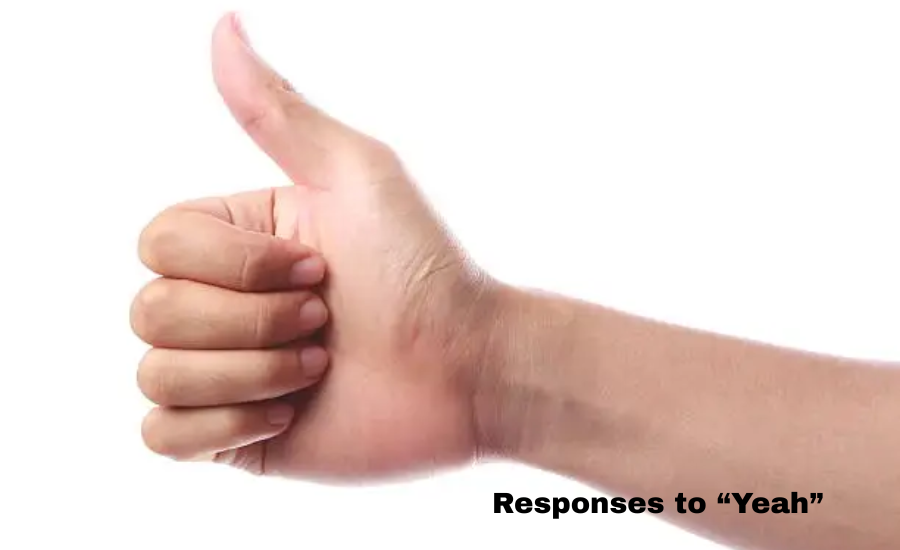The simple word “Yeah” may appear casual, but it is one of the most versatile and nuanced expressions in human communication. Depending on who says it and in what context, “Yeah” can convey enthusiasm, sarcasm, curiosity, or even complete disinterest. From romantic conversations to professional emails, understanding the tone behind “Yeah” is critical. In this guide, we categorize 160 unique responses to “Yeah” based on emotion, intent, and setting. We also look at how to interpret it using nonverbal cues, texting tone, and strategies for responding better. This guide will help you master the various meanings of “Yeah,” from deciphering a friend’s one-word response to crafting a clever comeback.
Meaning of “Yeah”
“Yeah” is an informal version of “Yes,” which is commonly used in casual speech and writing. But its meaning extends far beyond a simple affirmation. “Yeah” can mean:
- Agreement – A simple “Yes,” as in “Want to go out?” → “Yeah.”
- Disinterest is a flat response indicating boredom or lack of enthusiasm.
- Sarcasm, when used with a mocking tone or followed by “…right,” can imply the opposite.
- A cheerful, high-pitched “Yeah!” can convey excitement or approval.
- Uncertainty – A long “Yeah…” may indicate hesitation or doubt.
- Dismissiveness refers to a lack of genuine engagement with others.
“Yeah” can be positive, neutral, or passive-aggressive. That is what makes it so powerful and potentially confusing. Learning to decode the tone behind “Yeah” is critical for understanding what the speaker truly means.
Know Replies of “I Can’t Live Without You“.
160 Responses to “Yeah”
Affirmation & Agreement
1. Absolutely!
2. Definitely.
3. Yes, for sure.
4. Agree.
5. Exactly.
6. Without doubt.
7. You got it.
8. No doubt about it.
9. Totally agree.
10. Yes, indeed.
Responses to “Yeah”: Acknowledgment
11. I got it.
12. I understand.
13. I see.
14. Noted.
15. Roger that.
16. Copy it.
17. I hear you.
18. Right.
19. Okay.
20. Acknowledged.
Clarification and Confirmation
21. Are you saying you’re in?
22. Are you saying yes?
23. Could you confirm?
24. Is this a yes?
25. So you agree?
26. Do you agree?
27. Are you okay with it?
28. Is everyone on the same page?
29. Is this confirmation?
30. Do you mean “yes”?
Responses to “Yeah”: Curiosity / Inquiry
31. Why do you believe so?
32. What prompted you to say that?
33. Could you tell me more?
34. What do you mean by this?
35. How come?
36. What is your reasoning?
37. I am curious, why?
38. Could you elaborate?
39. What’s the story behind this?
40. What led you to this conclusion?
Encouragement & Support
41. That is the spirit!
42. Glad to hear it!
43. You are on the right track.
44. Keep it up!
45. You’ve got this!
46. Way to go!
47. Awesome!
48. Proud of you!
49. You are doing great!
50. Keep moving forward!
Surprise / amazement
51. Seriously?
52. No way!
53. Wow!
54. Seriously?
55. Are you joking?
56. Unbelievable!
57. That is incredible!
58. Are you joking?
59. Get out of here!
60. Cannot believe it!
Disinterest or dismissal
61. Okay.
62. Whatever.
63. “If you say so.”
64. Alright.
65. Fine.
66. Sure.
67. Cool.
68. I got it.
69. Right.
70. Okay, then.
Sarcasm and Humor
71. Oh, really?
72. Sure, why not?
73. Yes, right!
74. Of course, the sky is green.
75. Obviously!
76. Oh, 100%.
77. You didn’t say!
78. Sure, why not?
79. Absolutely, and pigs can fly!
80. Yes, and I am a superhero.
Follow-up Question
81. What will happen next?
82. And then?
83. What will you do about it?
84. What did you do after that?
85. How did things go?
86. What exactly do you mean?
87. Could you explain further?
88. What’s the current plan?
89. What are your next steps?
90. How did you feel about this?
Responses to “Yeah”:Encourage detail
91. Tell me more!
92. That’s fascinating. Go on.
93. Could you explain?
94. I’d like to hear more.
95. What else has happened?
96. Please provide the details.
97. I am all ears!
98. Fill me in.
99. Keep going, I’m intrigued.
100. Continue the conversation.
Contradiction / disagreement
101. I don’t believe so.
102: Not really.
103. I have a different viewpoint.
104. Not sure about that.
105. I see things differently.
106. I disagree.
107. My feelings are not the same.
108. This is not how I see it.
109. I believe that is incorrect.
110. I disagree with you on this.
Empathy & Concern
111. Is everything alright?
112. Do you need to discuss it?
113. How do you feel?
114. I am here for you.
115. That sounds challenging.
116. I understand.
117. Would you like to share more?
118. I am sorry to hear this.
119. That must be difficult.
120. Are you okay?
Transition / Topic Change
121. By the way.
122. Speaking of that…
123. On another note.
124. This reminds me…
125. Changing the Subject…
126. Oh, before I forget.
127. Unrelated, but…
128. While we are discussing this…
129. That aside…
130. On a different subject…
Expression of Excitement
131. Awesome!
132. Great!
133. Fantastic!
134. That is amazing!
135. How exciting!
136. Cannot wait!
137. Very cool!
138. I’m excited to hear that!
139. This is fantastic news!
140. Yay!
Expression of Indifference
141. Meh.
142. Okay, then.
143. Alright.
144. Whatever.
145. Noted.
146. I suppose.
147. Cool.
148. Sure.
149. Fine.
150. If you say so.
Responses to “Yeah”: Encourages action
151. Let us do it!
152. Go for it!
153. Make it happen!
154. You got this!
155. Take the plunge!
156. I believe in you!
157. Time to shine!
158. It’s your time!
159. Let’s move!
160. You can accomplish it!
Know Comebacks for “Age Is Just a Number”.
Tips for Responding Effectively to “Yeah”
Responding to “Yeah” may appear simple, but the word’s tone and context convey a variety of meanings. To keep conversations clear and engaging, here are some effective ways to interpret and respond to “Yeah” correctly.
1. Observe the tone
- A cheerful or upbeat “Yeah” typically indicates agreement or excitement. You can add to that by continuing the conversation or demonstrating similar enthusiasm.
- A flat or monotone “Yeah” may indicate disinterest or disengagement. This is an opportunity to check in or change the subject.
- A sarcastic or drawn-out “Yeah, right” typically indicates disagreement or disbelief. Recognize it and respond with humor or redirection.
2. Ask open-ended questions
- Encourage conversation with open-ended questions, such as “Yeah?” “What made you think that?”
- “That’s interesting.” “Can you tell me more?”
3. Pay Attention to Nonverbal cues
- In face-to-face conversations, pay attention to body language, facial expressions, and eye contact to determine what “Yeah” really means. If the tone of a text or message appears unclear, do not hesitate to ask for clarification.
4. When texting, clarify and re-engage
- To re-engage with someone who responds with “Yeah,” try asking, “Just checking—are you still into this topic?”.
- “Want to keep chatting or take a break?”
5. Mirror & Match Their Energy
- Maintain a natural conversation by matching their communication style.
- Respond to enthusiastic “Yeah”s.
- If the person’s tone is muted or neutral, ask a gentle question or make light observations.
- Do not assume disinterest without context.
- Do not end the conversation with a short “Oh, okay.”
- Avoid negative reactions to sarcasm and adjust the tone as needed.
- When receiving unclear responses, ask clarifying questions.
- Maintain an open and friendly dialogue.
- Adjust your response based on the setting, whether casual or professional.
FAQs
Q1: What exactly does it mean when someone says “Yeah” in text?
It depends on the tone and context. It could imply agreement, sarcasm, or simple acknowledgment.
Q2: How do I know if “Yeah” is sarcastic?
Look for cues such as timing, tone, body language (in person), and additional emojis/punctuation in texts.
Q3: Is “Yeah” appropriate for professional communication?
“Yes” is usually the preferred professional response. “Yeah” can sound informal unless you work in a relaxed environment.
Q4: What is the distinction between “yeah” and “yup”?
“Yeah” has a broader meaning and is tone dependent. “Yup” is usually more casual, but can also be playful or confident.
Q5: How should I respond when I’m not sure what someone means by “Yeah”?
Ask a clarifying follow-up question or respond with a slightly more open tone, such as “Got it, want to share more?”.
Conclusion
“Yeah” conveys emotion, tone, and context. Recognizing 160 possible Responses to “Yeah”, such as sarcasm, support, or disinterest, will help you read between the lines and respond with emotional intelligence. Understanding how “Yeah” works provides you with the ability to keep conversations alive, meaningful, and respectful, whether in a boardroom, a breakup text, or a funny chat with friends. So, the next time someone says “Yeah,” pay attention—because that small word may be saying a lot more than you realize.


